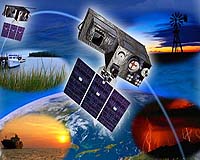 |
Istanbul, Turkey (SPX) Jun 02, 2009 AdaCore has announced that Astrium in the UK dedicated to providing civil and defense space systems and services, has selected the Ada programming language and AdaCore's GNAT Pro development environment for use on the new Sentinel-1 environmental monitoring satellite. Sentinel-1 is the first of five families of satellites being developed for the Global Monitoring for Environment and Security (GMES) program. GMES, a joint initiative of the European Commission and the European Space Agency (ESA), is designed to support a sustainable European information network by monitoring, recording and analyzing environmental data and events around the globe. The Sentinel-1 project is scheduled to be completed in October 2011. This instrument provides high-resolution satellite images by extending radar capabilities to penetrate forests and scrub to reach the ground, and registering any movements or changes on the Earth's surface within a resolution down to 5 meters. Astrium in the UK will use GNAT Pro to implement the Application Software for the SAR Electronics Sub-system which is used to control Sentinel-1's C-band Synthetic Aperture Radar (SAR). As part of the project, AdaCore will also port the GNAT Pro for LEON development environment to the Sensor Electronics Sub-system (SES) on-board computer, enabling compliance with the ESA's stringent ECSS-E-40B and ECSS-Q-80B space engineering and product assurance standards. The LEON2 processor was commissioned by ESA and designed specifically for use in satellite systems. "Sentinel-1 is a large-scale project that promises to deliver superior environmental monitoring capabilities," said Paul Southwood, software technical engineer, Sentinel-1 Onboard Software project, Astrium (UK). "We selected Ada based on its reliability and reusability and its strong track record in space applications. We also wanted a development partner that could provide the knowledge, flexibility and responsiveness to meet our specific needs and tight timescales. "Astrium has worked with AdaCore on a number of successful satellite and space projects, including the TerraSAR-X, which was the first German radar satellite for Earth observation. This experience combined with company's partnership approach and support capabilities made AdaCore the perfect choice for the Sentinel-1 project." "AdaCore has a long and successful history in the space industry," said Jose Ruiz, AdaCore's team leader on the GNAT Pro Sentinel-1 port. "We are pleased that Astrium in the UK has chosen GNAT Pro as its language technology solution for Sentinel-1, and we look forward to providing a product that will fully meet their project's requirements." Share This Article With Planet Earth
Related Links Astrium AdaCore Space Technology News - Applications and Research
 NOAA Selects Contractor To Develop GOES-R Ground System
NOAA Selects Contractor To Develop GOES-R Ground SystemWashington DC (SPX) May 29, 2009 The Commerce Department's National Oceanic and Atmospheric Administration (NOAA) has announced that Harris Corporation - Government Communications Systems Division of Melbourne, Fla. has been selected to develop the GOES-R ground system, which will capture, process and distribute information from NOAA's next generation geostationary satellite series to users around the world. The GOES-R ... read more |
|
| The content herein, unless otherwise known to be public domain, are Copyright 1995-2009 - SpaceDaily. AFP and UPI Wire Stories are copyright Agence France-Presse and United Press International. ESA Portal Reports are copyright European Space Agency. All NASA sourced material is public domain. Additional copyrights may apply in whole or part to other bona fide parties. Advertising does not imply endorsement,agreement or approval of any opinions, statements or information provided by SpaceDaily on any Web page published or hosted by SpaceDaily. Privacy Statement |